When your e-bike battery is dying, and you don’t have your charger, your first instinct might be to pedal your way to your destination… or panic! But if you understand your battery charging options, this worry will never become a reality.
Luckily, there are several ways you can charge your electric bike’s battery:
- Portable charger or power bank
- Solar Panel
- Car Battery
- Pedal Charging & Regenerative Braking
- Charging Station
- Generator
In this article, I’ll cover how electric bike batteries work. Then, I’ll go ahead and tell you the easiest methods to charge your e-bike’s battery.
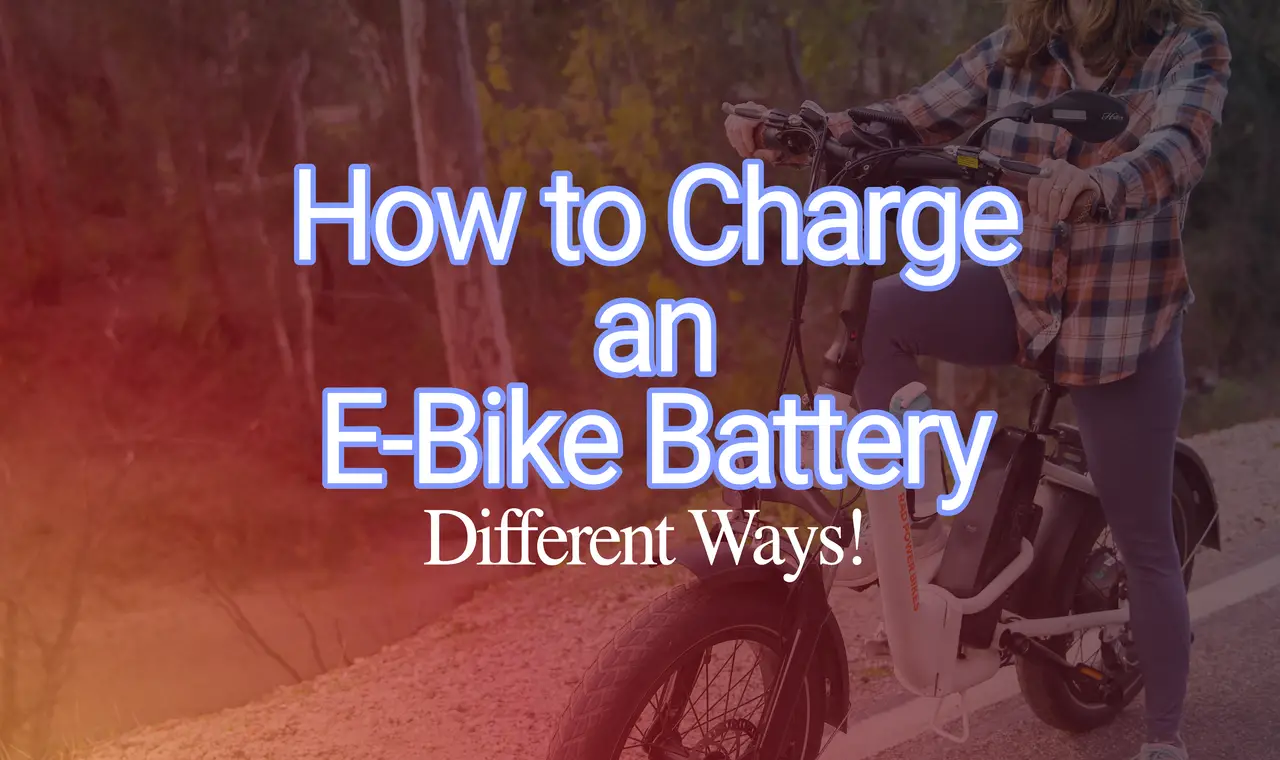
How Do Electric Bike Batteries Work?
E-bike batteries have undergone several stages over the years, from the good old lead-acid “SLA” batteries to nickel batteries, and finally to the lithium chemistry batteries.
Nowadays, most electric bike batteries use lithium.
These groundbreaking lithium-ion batteries revolutionized electric bikes. Their power supply is significantly higher than the earlier electric bike batteries, thanks to an intelligent battery management system. In addition, they are smaller and lighter.
Besides their convenient size and efficient energy storage, they are long-lasting and can charge quickly. This makes them the go-to battery technology for many modern devices such as computers, smartphones, electric cars, and so on.
A lithium battery can often sustain over a thousand charging cycles, bearing in mind that each charge entails an empty battery becoming a fully charged one. This is a huge leap from the SLA and nickel batteries that can only undergo 300 to 500 charging cycles.
An electric bike battery is typically expensive. However, their efficiency and long-lasting durability make them worthwhile in the long run.
As with all batteries, electric bike battery cells will lose capacity and give out someday. Still, with the proper care, you can ensure maximum battery life.
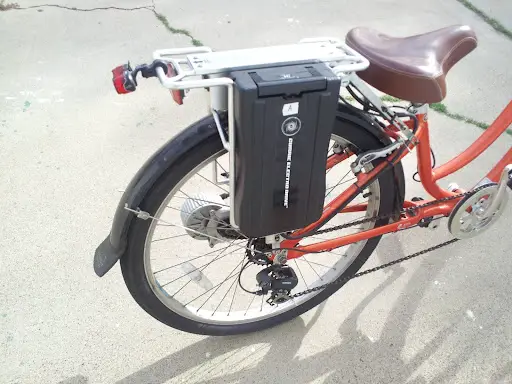
How to Maximize Your Electric Bike Battery Life
Your e-bike battery has a limited shelf life. To get the best from it, there are several measures you can take.
Use the Appropriate Charger
It’s important only to use the charger supplied with your electric bike. Any other charger will probably not be compatible with your battery pack, resulting in decreased battery life.
Don’t Drain Your Battery
You should try not to end up with a completely drained battery if you can help it. While this might occur occasionally, you should make sure it isn’t frequent; your e-bike battery life can decrease significantly with regular discharging.
However, you also don’t need to charge fully after every ride.
Do Not Leave A Charger Permanently Connected
An electric bike battery can take several hours to charge to full capacity. It’s easy to leave your bike’s battery charging overnight or for much longer than is intended.
When plugged in all the time, an electric battery can be prone to damage from the continuous heat and won’t last as long, not to mention the waste of electricity and the fire hazard posed by the constant heat.
Make sure to charge the battery as requested in your electric bike instruction manual.
Keep Your Electric Bike Battery in Suitable Conditions
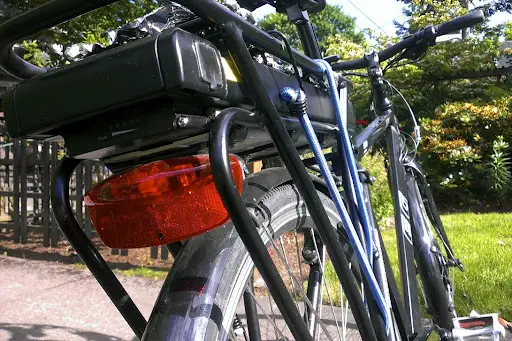
Exposure to inadequate conditions such as extreme heat, humidity, and moisture for an extended period of time can significantly damage the bike’s battery cells.
Lithium batteries prefer a cool to moderate temperature, ideally between 0°C (32°F) and 30°C (86°F). Leaving an electric bike battery in hot conditions will result in a quick deep discharge. Again, that is best avoided. Unless it’s terribly hot or cold, most indoor and outdoor temperatures will be fine.
Humidity is another risk not only to e-bike batteries but to all electronic devices. Make sure your battery pack is stored in cool and dry conditions.
Read these charging tips for more info!
5 Ways to Charge Your Electric Bike’s Lithium Batteries
Before you reach for your main e-bike charger, there are other options to explore.
1. Power Bank Or Portable Charger
Most electric bikes will last for dozens of miles when the battery capacity is topped off.
However, your battery range, meaning how long you can ride on a single charge, might be affected by several factors such as the load on the electric bike, the weather conditions, the nature of the terrain, and how much pedal assistance you’re using.
Even if you think your e-bike’s battery should easily take you to your destination, it helps to carry a portable charger (the one that came with your battery) or power bank to charge the battery in case of an emergency.
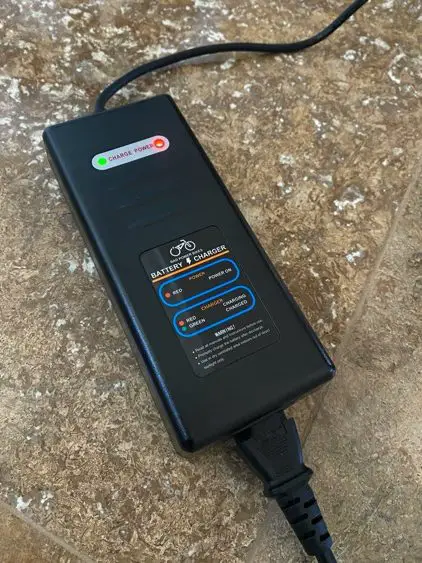
For this to work, your power bank needs to satisfy the power supply requirements of your battery pack in terms of amperage and voltage. As with charging any mobile device, you can go a little higher than the requirements but not the other way round.
A power bank or portable charger can charge your e-bike battery up to a certain point, depending on your electric bike battery capacity.
An important thing to consider is the weight of your portable charger or power bank.
Since you’ll need to carry it around, it has to be light enough. Unfortunately, some of the heavier electric bikes require a great deal of energy. Accordingly, power banks capable of charging such e-bikes can be quite heavy.
All in all, portable power banks have come a long way and are especially useful if you’re riding someplace where there are no wall outlets and power sources.
2. Solar Panel

Channeling solar energy to charge an electric bike battery is a method that’s growing in popularity. If you often ride off-grid, you’ll find that having a solar power system is very useful.
There are several ways you can go about this, and they are all relatively easy to get your head around. You can go for a 100W or 200W solar panel, a solar generator, or your own converting system. Take a look at the HQST 100 Watt Polycrystalline 12V Solar Panel on Amazon.
For this, you’ll need an inverter to channel energy from the solar panel into your e-bike battery. Using an MPPT boost solar charge controller, which usually comes with solar panels, will optimize the amount of drawn current and increase the charge rate significantly.
The efficiency of this method will largely depend on the power requirements of your electric bike. More often than not, e-bike batteries can be quite demanding and will take a couple of solar panels to charge effectively.
However, a power solar system can be a great way to charge your e-bike battery, particularly for adventurous minds who like to spend plenty of time off-grid.
Luckily, modern solar panels are lightweight and can be transported fairly easily, more so if you have a car or minivan to assist you in parts of your travels.
Read the complete guide on charging your e-bike with a solar panel!
3. Car Battery
An alternative way to charge electric bike batteries is through car batteries. Since a car battery runs on a much stronger current.
While this is a viable option when there’s no other way, there’s a risk of draining the car battery. To overcome this, consider charging your e-bike battery just enough so it can hold on until you are able to charge it normally.
To be safe, you can use an alternator tester to cut the power supply in case the battery loses power. In addition, the energy monitor will be helpful so you’ll know the amount of power that is sent to your electric bike.
The best bet is to use a power inverter to help regulate the voltage being sent to your e-bike (like this one on Amazon):

I talk in-depth about using a car battery and inverter to charge your bike in this article.
4. Pedal Charging & Regenerative Braking
Unfortunately, most e-bike batteries do not charge while you’re pedaling. However, many e-bikes are designed with regenerative technology intended to preserve the e-bike battery when braking.
The energy created when pedaling is usually lost. Electric bikes that use regenerative braking allow you to preserve a certain amount of that energy. This isn’t to say that your e-bike battery will actually recharge, but the energy preserved when braking will extend your battery range.
Regenerative braking will only preserve around 10% of your battery energy. However, this can be very useful in dire situations.
5. Charging Station
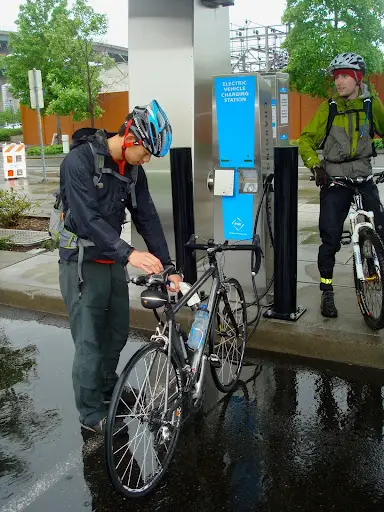
When it comes to charging your electric bike battery on the road, your best bet will be to find a charging station. This is one of the easiest and most efficient ways to charge your e-bike when you’re away from home.
The good news is that you can find these charging stations in many places.
If you brought along your charger, you can use charging points or bike stands and plug your electric bike into the power outlet. There are also e-bike lockers available in some commercial stores where you can remove your battery pack and place it inside the locker to recharge. These offer better protection against theft.
Luckily, more and more e-bike charging stations have been made available in public places such as restaurants, gas stations, libraries, camping sites, fire stations, and so on.
An electric bike battery typically takes several hours to recharge. Public charging stations are very convenient in this regard; you can simply stop for a coffee or a meal while you wait for your e-bike to charge.
If you’re going for a long ride on your electric bike, a great idea is to plan your stops ahead of time. You can easily find charging stations on the map or download one of several apps that can show you where the nearest e-bike charging stations are.
6. Generator Charging
E-bike riders living the RV or camping life may wish to use a generator to recharge.
You can use a generator to charge your ebike, but it must supply the correct wattage. Thus, you need to match your battery’s watts with that of the generator. A 500 W battery needs a minimum 500 W generator.
Your RV generator can’t be used if it doesn’t have sufficient wattage for your high-powered electric bike. Further, you’ll need to make sure that you will be in a location to plug into a power source, which all campsites do not have.
The 3000W generator below (Amazon) should be enough to power any e-bike:

See the complete discussion on using a generator to charge your bike battery.
Final Thoughts
If you’re planning to ride your electric bike for a long distance, it’s natural to worry about your battery range and charging cycle. While it always helps to have an extra battery, it might not be an option. After all, a new battery can be quite expensive.
Luckily, electric bike battery charging really isn’t that hard. There are many ways you can recharge your electric bike battery and enjoy a long ride.
Electric bike owners might also like to read:




